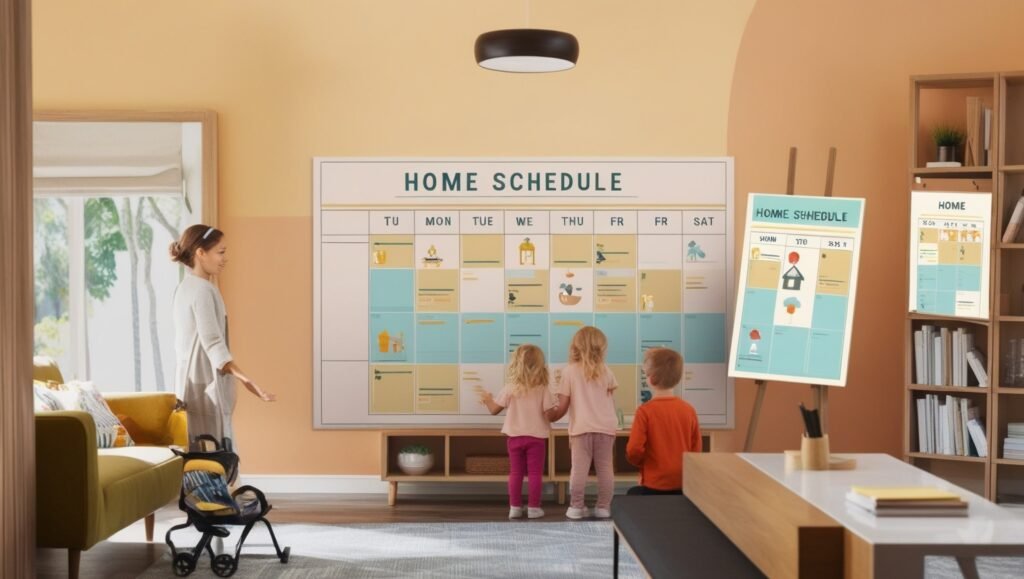
A homeschool preschool schedule is the key to creating a balanced and engaging learning experience for young children. Homeschooling can feel overwhelming, but using a loop schedule offers a flexible and stress-free way to structure your days.
Unlike rigid timetables, a loop schedule allows parents to rotate subjects and activities based on progress rather than a fixed calendar. This personalized approach ensures that learning remains fun, adaptable, and tailored to each child’s needs.
Experts like Jeannie Fulbright, with 25 years of homeschooling experience, swear by loop scheduling. They believe it reduces burnout, encourages deeper learning, and helps parents craft an educational journey that suits their child’s unique learning style.
By incorporating a homeschool preschool schedule with a loop system, families can enjoy a structured yet flexible routine that maximizes learning while keeping stress levels low.
Table of Contents
What is the Loop Schedule Homeschooling
Loop scheduling is a new way to homeschool that changes the traditional approach. It gives families more freedom in learning. Your homeschooling can be more flexible and meet your kids’ unique needs.
At its heart, loop scheduling makes learning flow smoothly. Subjects change when they’re done, not by a strict schedule. This way, you can learn without the stress of a tight schedule.
Core Components of Loop Scheduling
The main parts of a loop homeschool curriculum are:
- Flexible subject rotation
- Adaptable learning pace
- Reduced scheduling pressure
- Personalized educational progression
Benefits of Flexible Learning Approach
Loop scheduling has big benefits for homeschooling families. About 90% of parents feel less stressed with this method. It lets you:
- Improve student engagement
- Explore subjects more deeply
- Handle unexpected events easily
- Learn at your own pace
Traditional vs Loop Scheduling Comparison
Loop scheduling is different from traditional schedules. It offers a more natural learning experience. Your homeschooling can fit your family’s needs and life’s surprises.
Choosing loop scheduling means focusing on quality learning. It lets students explore subjects deeply while keeping a flexible schedule. This way, learning is both structured and adaptable.
Creating a Customized Education Path Through Loop Scheduling
Loop scheduling changes how you think about education. It focuses on what your child needs to learn. This method lets you create a learning plan that fits your child’s strengths, interests, and challenges.
The B.R.I.G.H.T. approach helps you make a personalized homeschool plan:
- Brain Dump: List all potential learning activities
- Relevant: Identify core educational objectives
- Individualize: Tailor the schedule to your child’s learning style
- Game Plan: Develop a flexible learning strategy
- Highlight: Emphasize key learning opportunities
- Test & Tweak: Continuously refine the approach
Loop scheduling makes mastery-based learning easy. It lets students focus more on hard subjects. This way, they don’t fall behind. Studies show 75% of homeschooling parents see better results when they adjust to their child’s learning style.
Loop scheduling lets your child take charge of their learning. It’s flexible, so you can adjust to different learning speeds. This ensures your child understands deeply, not just completes tasks.
Essential Elements for Implementing a Successful Loop Schedule
Creating a good homeschool plan needs careful thought and smart steps. A loop schedule lets families make a learning path that fits their needs.
Starting a loop schedule involves key parts. These parts turn your learning space into a lively place for learning.
Setting Educational Goals
Having clear learning goals is the base of a good homeschool plan. Here are some important steps:
- Set clear goals for each subject
- Make milestones to track progress
- Match goals with your child’s learning style
- Check and change goals every quarter
Time Management Strategies
Good time management is key for flexible homeschooling. Families can make the most of their learning by:
- Creating a daily routine that works
- Setting aside time for main subjects
- Adding time for surprises in learning
- Using planners to keep track of progress
Resource Organization
Good self-paced learning needs organized resources. Make your homeschool better by:
- Having a special place for learning
- Organizing digital and physical materials
- Keeping a flexible library of resources
- Updating your learning tools often
Remember, the secret to a great loop schedule is being flexible but keeping up with learning.
Charlotte Mason’s Philosophy and Loop Scheduling Integration

Charlotte Mason’s educational philosophy is a great fit for loop scheduling homeschooling. It focuses on student-led learning and a whole-child approach. This makes it perfect for flexible homeschooling methods.
Mason’s ideas match loop scheduling well. It involves short, fun lessons and lets kids follow their interests. This way, parents can help their children grow intellectually in a lively learning space.
- Embrace living books that inspire curiosity
- Integrate nature studies into weekly learning cycles
- Prioritize depth of understanding over rote memorization
- Create space for personal reflection and exploration
Loop scheduling is especially good for student-led learning. It lets kids explore topics they love deeply. At the same time, it keeps learning structured.
Learning should be a joyful journey of discovery, not a rigid checklist of tasks.
Mason’s view sees education as inspiring, not just a routine. With 75% of relaxed homeschooling families using flexible plans, loop scheduling is ideal. It brings her ideas to life.
By mixing Mason’s ideas with loop scheduling, you can tailor learning to your child. It respects their unique way of learning and curiosity.
Building Student Independence Through Self-Paced Learning
Loop scheduling changes how we learn by letting students control their education. As education changes, learning on your own is key for success. With 60% of today’s kids likely to work in jobs that don’t exist yet, learning to learn by yourself is crucial.
Learning on your own needs a smart plan that mixes guidance with personal effort. The goal is to help students grow while keeping learning standards high.
Developing Time Management Skills
Managing time well is vital for learning at your own pace. Students can improve their time management by:
- Creating personal learning schedules
- Setting realistic daily goals
- Using digital and analog tracking tools
- Breaking larger tasks into smaller ones
Fostering Self-Motivation
Being motivated from within is key for self-paced learning. Ways to boost student interest include:
- Linking learning to what they love
- Celebrating small wins
- Offering feedback that matters
- Letting them choose what to learn
“Education is not the filling of a pail, but the lighting of a fire.” – William Butler Yeats
Creating Accountability Systems
Having a system to keep students on track is important. Use methods that track progress without being too strict, like:
- Weekly check-ins
- Digital learning portfolios
- Self-reflection journals
- Goal-setting workshops
By adopting self-paced learning, students gain skills that go beyond school. These skills prepare them for a future that’s full of surprises.
Adapting Loop Schedules for Different Age Groups

Flexible homeschooling means changing with your child’s growth. Loop schedules are a great way to tailor learning to each age. They meet the unique needs and abilities of every child.
For little ones, loop schedules are all about fun. They might include:
- Story time
- Outdoor exploration
- Art activities
- Music and movement
- Free play
Older kids need a loop schedule that’s a bit more set. It should cover the basics but still be flexible. A good mix includes:
- Core subjects like math and language arts
- Science exploration
- Social studies
- Creative subjects
Teenagers need even more from their loop schedules. They should focus on:
- Independent study skills
- Advanced core subjects
- Elective exploration
- Project-based learning
Parents using loop schedules for homeschooling should keep these tips in mind:
| Age Group | Loop Duration | Subject Focus |
|---|---|---|
| Preschool | 15-20 minutes | Playful learning |
| Elementary | 20-30 minutes | Core academic skills |
| Middle/High School | 30-45 minutes | Advanced subjects, independent learning |
Flexibility is key in making a good loop schedule. Always check in and be ready to make changes. This keeps homeschooling fun and effective.
Incorporating Interest-Driven Learning into Your Loop Schedule
Making homeschooling more engaging is key. By focusing on what interests your child, learning becomes a fun journey. This way, your child’s education feels personal and powerful.
Good homeschooling mixes structure with your child’s passions. This lets them dive into subjects they love. It also makes sure they get a well-rounded education.
Identifying Student Passions
Finding out what your child loves takes time and talking. Here are some tips:
- Watch what they do naturally and what they ask about
- Talk about their favorite books, TV shows, and hobbies
- Look for online resources that match their interests
- Support their curiosity with hands-on projects
Balancing Core Subjects with Interests
You don’t have to give up on core subjects. Link required subjects to their interests to keep them engaged and learning well.
Project-Based Learning Integration
Project-based learning is great for mixing learning with exploration. By creating projects based on their interests, learning becomes an exciting journey.
- Choose projects that tie together different subjects
- Let them choose how to research and present
- Support their learning but don’t control it too much
Conclusion: Embracing the Freedom and Flexibility of Loop Scheduling
Your homeschool journey can change with a loop homeschool curriculum. This method offers flexibility. It lets you adapt learning to your family’s unique rhythm.
Loop scheduling makes learning more organic and responsive. It removes the stress of strict daily timelines. You can rotate subjects naturally while keeping up with educational progress.
Personalization is the key strength of loop scheduling. Each family can create a learning experience that fits their goals and learning styles. It works for managing multiple children or supporting a single learner.
Start exploring loop scheduling techniques for a more relaxed homeschooling experience. Connect with homeschooling communities. Remember, your educational journey is unique. Embrace the freedom to learn, adapt, and thrive together.
